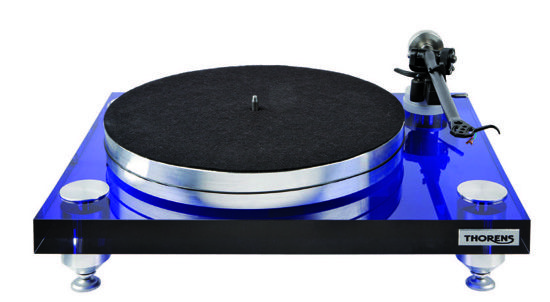Thorens Td2030a (£2475)

Part of Thorens’ Acrylic Series, the TD2030A sports a 33mm-thick plinth made up of two 15mm slabs of clear acrylic with a 3mm blue tinted layer sandwiched between. Looking edge-on, the plinth appears clear with just a thin dark line, but from any other angle, it’s filled with gorgeous colour, like the blue of the Aegean under a cloudless sky.
The plinth stands on three imposing legs. These end in small pointed feet that screw in or out for levelling adjustment. At the back left corner, a circular cut-out accepts the drum-shaped separate free-standing motor unit. This itself weighs more than 1.3kg and stands on its own six small soft feet, of Neoprene-type material. Projecting above the plinth is the polished metal pulley which drives the platter by a thin square-section belt.
The platter is aluminium, with a dense composition filling bringing the weight up to 6.2kg. It runs on a conventional-enough main bearing while a Teflon thrust pad at the bottom supports the radiused bottom end of the shaft.
On/off switching and 33.3/45rpm speed change is provided by two neat toggle switches on the separate Thorens PS800 ‘steering’ control unit. Such a heavy platter is a demanding load for a belt-drive system, and to get it moving quickly takes more motor power than maintaining speed once running.
In the Thorens control unit, this is dealt with by having what Heinz Rohrer calls a ‘first gear’. When the controller is switched on, more power is applied for the first four or five seconds to get the platter moving quickly. After this the supply system reverts to normal ‘second gear’ operation to keep the deck running at the correct speed.
Completing the package is a Thorens TP300VTA tonearm, which is in fact a Rega RB300. This has the original simple pillar mount, rather than the more recent Rega threepoint mounting. Thorens has added its own adjustable collar clamp to give VTA adjustment. After slackening the hex bolt on the collar, you can slide the pillar up or down in the collar and so adjust the arm height to give correct VTA.
QUITE A STRETCH...
With Dead Set, the Grateful Dead’s 1980 live album, the TD2030A gave an expansive soundstage, stretching beyond the confines of the speakers. There was a quite convincing stage placement of instruments, so you could appreciate the interplay between Garcia’s stinging guitar and Mydland’s chunky organ sounds.
As always on this recording, the lead vocals sounded a little recessed, but there was a good sense that this was a real live performance. With the Ortofon Vivo Blue cartridge used, we felt that the turntable’s bass was slightly reticent but it was rhythmically impeccable.
Moving on to classical music, with the well-known 1963 English Music For Strings with Barbirolli, the Sinfonia of London and the Allegri Quartet [EMI ASD 521], we felt that the overall picture was really enticing, with a great feeling of depth and presence. Even though the sound was less refined in terms of detail than it can be with more expensive cartridges, there was still a fine sense of scale to the strings.
This prompted a move to the Benz Micro Ace cartridge. It was lovely to hear an even better sense of space now on the English Music For Strings with Barbirolli. In the Elgar Introduction and Allegro, the balance between quartet and large string group was finely conveyed, the music moving forward with a sprightly pace.
VERDICT
Relying on mass rather than any form of suspension, this turntable may confound expectations as it produces a rhythmically engaging sound. With the industry-standard Rega arm, it should do justice to exotic cartridges. Though this package is fairly expensive, it boasts excellent finish and stunning looks to match the lively sonics.

























































